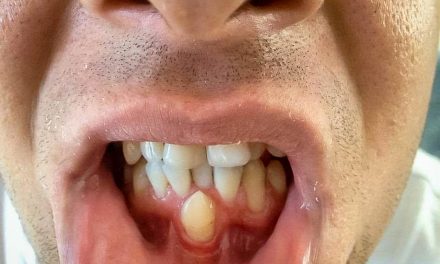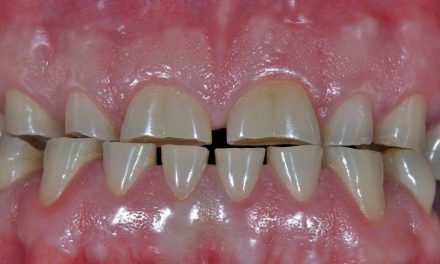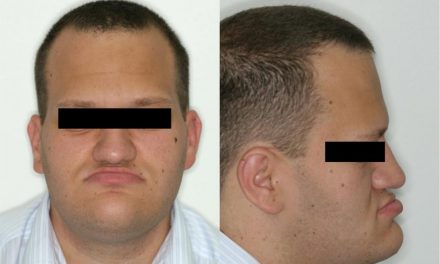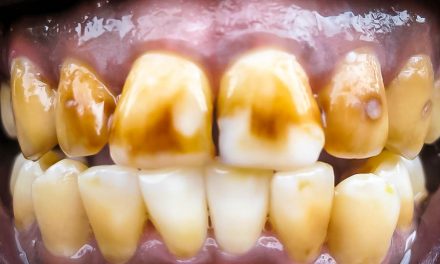Dry socket is a painful complication that occurs a few days after tooth extraction, mostly following the removal of lower wisdom teeth. It is due to the loss of the blood clot, hence exposing the bone and nerve endings of the socket to the mouth.
Alveolar osteitis is a medical term for dry socket. Alveolar means the part of the jawbone that supports teeth. Osteitis means bone inflammation.
A dry socket is not an infection, and is not related with swelling. It is an occurrence of inflammation within the bone of an empty tooth socket.
Mechanism
Dry socket appears mainly following the extraction of a lower back tooth, and smokers are more likely to suffer from it
After tooth extraction a blood clot is developed in the socket to help stop bleeding. It is also the foundation for new tissue and bone to develop over the healing process.
Dry socket occurs usually three to five days after tooth extraction and is caused by the dislodging of the blood clot from the surgery site. When bone is exposed, it induces intense pain which may be followed by a bad smell or taste, and difficulty of opening the mouth.
Dry socket occurs following about 5-10% of extractions, and this mainly at the lower and back teeth area.
Dry socket happens mostly in these cases:
- Patients who do not care for their extraction site as instructed.
- Patients who smoke within 72 hours after tooth extraction.
- Patients who undergo sucking action from smoking or drinking through a straw.
- Women who use oral contraceptives.
Signs and symptoms
After any tooth extraction there is a period where the patient experiences pain, especially if the extracted teeth were impacted, such as with wisdom teeth. However, dry socket appears as a sudden increase in pain a few days after extraction. Here are the main signs of alveolar osteitis:
- Sharp pain which starts three to five days following tooth extraction.
- Pain that radiates up and down the neck, the ear, and the head on the same side where tooth extraction was done.
- Bad taste or smell in the mouth.
- Difficulty of opening the mouth.
- If swelling is present, it is not directly linked to the dry socket.
Prevention
 It is important to stick to post-extraction instructions as advised by the dentist. Here are some recommendations to follow:
It is important to stick to post-extraction instructions as advised by the dentist. Here are some recommendations to follow:
- Avoid smoking for at least 72 hours. Smoking contaminates the extraction site, and the sucking action on a cigarette or a cigar can dislodge the blood clot.
- Avoid drinking through a straw as the negative pressure created by drawing liquids through the straw can dislodge the clot.
- Avoid excessive mouth rinsing; start rinsing with warm salted water three times a day in a soft manner, but only 24 hours after the extraction was done.
- Chew food away from the extraction area to avoid it from impacting the socket.
- Women who use oral contraceptives are twice as likely to develop dry socket after an extraction.
- Women are at higher risk than men of getting dry socket, because estrogen, which levels are high during the three first weeks of the cycle, slows down the healing process. Dentists sometimes recommend that their female patients have extractions performed during the last week of their cycle, when estrogen levels are lowest, to minimize chances of developing dry socket.
Treatment
The pain caused from dry socket usually lasts from 24 hours to one week. There is no miracle treatment as alveolar osteitis is a temporary condition that will disappear with time.
However, there are particular interventions that can decrease pain during an episode of dry socket:
- Placement by the dentist within the socket of a type of sedative dressing (zinc oxide, eugenol, and oil of clover), which soothes the inflamed bone for a period of time and promotes tissue growth.
- Because true dry socket pain is so intense, additional analgesics are sometimes prescribed.
- It is important to continue home care instructions like to avoid smoking and drinking through a straw until dry socket symptoms disappear.
References
- Alveolar osteitis (Wikipedia, the free encyclopedia).
- Dry socket (Mayo Clinic, medical information and tools for better living).
The information above should be used as a reference only. Any medical decision should not be taken before consulting a health care professional.
The masculine gender may have been more used in the article, but without prejudice, to make reading easier.
Category dental problems
- Abfraction
- Abrasion
- Ankylosis
- Anodontia
- Attrition
- Broken fillings
- Bruxism (Teeth Grinding)
- Cavity (tooth decay)
- Cold sore (herpes labialis)
- Dental abscess
- Dental plaque
- Denture Irritations and Infections
- Denture stomatitis (prosthetic stomatitis)
- Dry socket
- Erosion
- Fluorosis (dental)
- Gingival hyperplasia
- Gingival pocket
- Gingivitis
- Gum Disease (Periodontal Disease)
- Gum recession
- Halitosis (Bad Breath)
- Hyperdontia (supernumerary teeth)
- Hypocalcification
- Hypodontia
- Impacted tooth (tooth impaction)
- Leukoplakia
- Lichen planus
- Malocclusion (Misaligned Teeth)
- Microdontia
- Micrognathia (micrognathism)
- Mucocele
- Oligodontia
- Oral cancers
- Oral candidiasis
- Overbite
- Overjet
- Pericoronitis
- Periodontal pocket
- Periodontitis
- Prognathia (prognatism)
- Resorption
- Retrognathia (retrognatism)
- Sleep apnea
- Tartar (Calculus)
- TMD (Pain and Cracking of the Jaw)
- Tooth Discolouration
- Tooth sensitivity (sensitive teeth)
- Torus
- Trismus
- Ulcers and canker sores
- Xerostomia (Dry Mouth)





